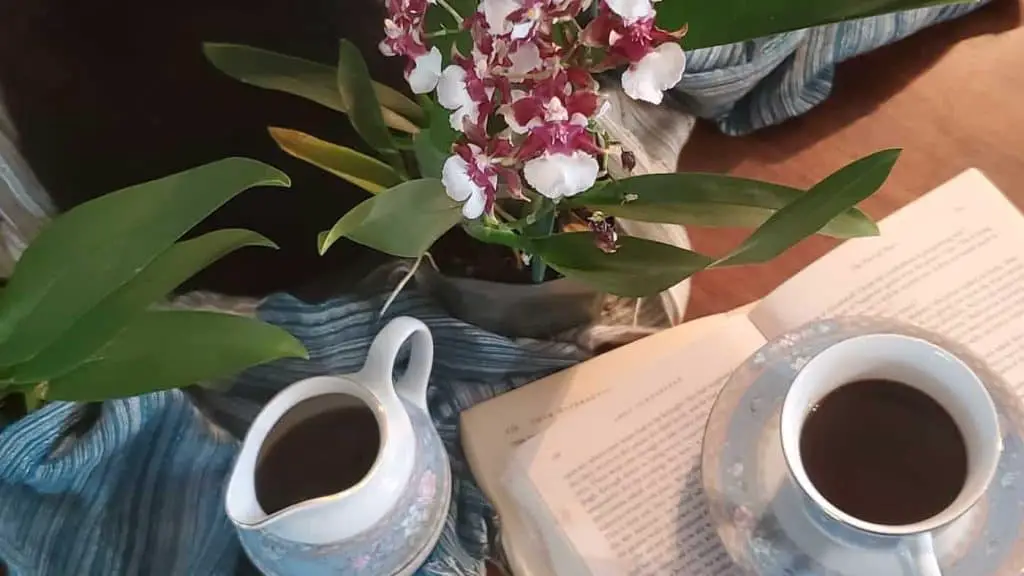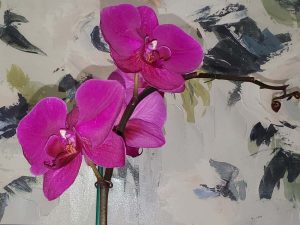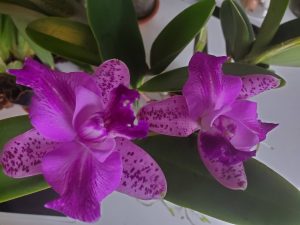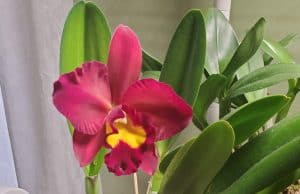New orchid buds are a sign of congratulatory reward. You’ve taken care of your orchid for almost a year and a flower spike emerged. As a newly “expectant” orchid hobbyist, you anticipate with great joy the new orchid blossom with all its bright and exotic colors.
It’s finally time to sit back and enjoy your hard work.

New buds appear, and you’re even more overcome with joy.
Not that orchids are a lot of work or high maintenance, but all the investment you’ve done in proper care is now going to pay off.From the blue, the first orchid bud turns yellow, shrivels up, dies, and falls off.
Not only does it stop growing, but it just gives up on life—without any signals. No warning signs, no hints demanding changes, nothing… Then the second orchid bud wilts, dying without reason. In panic, you don’t know what to do.
This is called bud blast. What causes bud blast in orchids?
Bud blast in orchids occurs when abrupt changes in the environment are too harsh for the orchid to adjust to, so the orchid withdrawals the blossom growth to preserve energy. These changes can be in temperature, lighting, humidity, watering, surroundings, or even insects. To salvage the rest of the buds from blasting, you need to identify what the cause is and treat it soon.
At this stage you can prevent the other orchid buds not blooming and just dying if you are quick to diagnose what the orchid is reacting to and fix it. Before you identify the problem, think back to how you were caring for your orchid.
In those conditions, the orchid had enough nutrients to produce a flower spike. The lighting was sufficient to grow this spike enough to produce the first buds. The watering was adequate for other buds to develop.
But something changed—something drastic.
All the sudden the orchid no longer feels the safe environment and decides to retreat. The orchid buds fall off. Your orchid needs to save energy, and blossoming will cost tons of energy to the plant.

For example, if all the sudden the orchid lost its light source, it needs to converse energy until it feels like it’s in a light enough place to live adequately again.
This is usually what happens when we move orchids around inside our house, from window sill to living room table, to spare bedroom, to bathroom. And in the bathroom, the humidity levels fluctuate more than the Kansas temperatures during fall. All these changes signal to the orchid that it’s not the right time to flower.Result: bud blast.
Below are the common causes of orchid bud blast. Read each one, because sometimes the factor is not a single cause. The reasons may be as simple as you brought the orchid home from the grocery store or garden center and the environment is so different, the orchid goes through culture shock.
Changes in Atmosphere Cause Bud Blast
Like any household plant, orchids can feel the changes in the environment around them. Change the curtains to a thinker fabric. With less light, the orchid will produce more chlorophyll to respond, absorbing the most sunlight it can. In turn, the leaves turn darker green before they die—hopefully they won’t die, but you get the point.
Orchids react to the chemical reactions from sun light, air circulation, humidity, and chemicals in the surroundings. “Heavy air” can cause the orchid bud to wrinkle.
Observe an orchid that has been placed in a house with a smoker. This will take a few months, of course, but changes will occur. The chemicals and pollutants in the air affect the orchid. You might be thinking that orchids purify the air, and in this article, named “Do Orchids Purify the Air?”, I explain why you shouldn’t purchase an orchid for that purpose.
A common mistake in air quality that causes bud blast is house paint.
We don’t let our children sleep in a freshly painted room due to toxins, but in our redecorating vibe, we rush to results. Tin order to see the finished results of how the “after picture” looks, we place the orchid in that room, along with all our other paraphernalia: books, armchair, desk, office supplies.
And once was a happy orchid…
Chemical reactions come from ripening fruit, too. If your orchids sit next to a fruit basket, make sure you eat the fruit. Don’t let the fruit ripen, an ripen, and ripen… Turning to mush.
Overly ripe fruit produce chemical toxins that not only attract fruit flies, but also kill orchids.
Make sure you have air circulation at all times for your orchid. Not only does this flush out the environment, it also circulates the stagnant humidity. If your dog or cat can breathe safely in the room, then so can your orchid.
Temperature Change Causes Orchid Bud Blast
Sudden drastic changes in temperature are the most common culprit of bud blast, because we usually do these without noticing. All the other signs involve our drastic change in habits when caring for an orchid, but temperature goes unnoticed.
The sudden temperature oscillation can also be from having the orchid in your car in winter and carrying it into your house in less than humane temperatures.
(Remember, I’ve lived in a tropical climate all my life, so Kansas winter weather for me is inhumane. 😊 )
Yet, it’s autumn, and the temperatures outside are starting to drop a bit. If your orchid gets as rush of cold, freezing air from an open window, this is enough to shock it’s “fight or flight” response system.In return, the orchid bud shrivels.
Another habit of ours: redecorating. Orchids fix themselves onto trees, where conditions are the same year-round and they don’t have to go through constant changes. Adaptations are not an orchids specialty, unless it’s over hundreds of thousands of years.
By the way, there is an interesting article about orchid adaptions here. Day-to-day adaptations are not handled well. Given time, your orchid will adapt well to its new environment, but don’t keep redecorating your home every other week.
Moving the orchid over from a shelf to an end table, but not realizing that on the floor lays a hot air vent: this will evoke bud blast. This unusually hot and dry air shocks the orchid and it draws back, causing orchid bud blast.
Kitchen orchids have this problem. The best place for an orchid is by the window, but this usually means that heat from boiling water that you pour into the sink will float up to scorch it. Or placing the orchid by the oven: every time you bake biscuits, and open the flaring 375ºF oven door—wham.
There goes your orchid…
You might not notice a temperature change at first, but even if you move an orchid closer to the window sill, this may be enough to heat the leaves too much. All year long it was used to receiving light behind six other plants, with no direct sunlight. All the sudden it gets honor seats in front of the window. It might love the light, but the heat is too much for it to withstand.
Think about what change has occurred recently in temperatures, and try to reverse the change. Most the time, there is nothing to do once the temperature shock has occurred.
Some orchids will need extra heat in the winter. Cattleyas are a perfect example. Since they grow in hot savanna grasslands in Brazil, they aren’t accustomed to the extreme drop in temperature during the day. At night it’s beneficial, but not during the day. Use a heating pad (Affiliate Link)  to provide the correct temperatures yearound, making sure that you see that drop at night of 10-15 degrees F, or 8 C.
to provide the correct temperatures yearound, making sure that you see that drop at night of 10-15 degrees F, or 8 C.
Over-watering and Under-watering Can Cause Bud Blast
Over-watering is not usually a cause for bud blast, because if you’ve been watering the same way as before, maintain a solid routine, then there is no reason to suddenly occur bud blast. It could be that the city has changed the chemicals in the water supply, but this usually is not to a degree that is noticeable, or that would cause bud blast.
Cattleyas sense over-watering more than other orchids. Root rot will occur, but this usually takes more time, if continued to an extreme. The orchid buds will darken, leaning toward a darker color than the open blossom.
Sometimes when a new orchid grower sees the first bud, they get excited and want to provide “more care.” They mist more. They water more. They put the orchid closer to the light… You get the point.
Excess watering when buds are in the sheaths can cause certain fungus and bacteria to proliferate, destroying the bud before it opens. Be extra careful when misting to only mist what is necessary.
Under-watering is another culprit when coming to watering. You went on vacation. Your child got sick and you spent a lot of time at the hospital. Or, you moved the orchid to the spare bedroom and since you have no guests… Well, it got forgotten. Out of sight—out of mind.

In the under-watering scenario, the orchid will withdraw water from the buds, retaining it closer to the crown.
It does this to preserve the last drops of water. Blossoming and budding require extreme amounts of water, so in self-care, the orchid aborts the bud.Check the roots to see if they are a healthy green color and return to the watering habits that you were using before.
Wrong Light/Heat Causes Orchid Bud Blast
Light goes hand in hand with heat. Sometimes it’s not the light that causes the orchid to abort the buds, but the excess heat that comes with the light. Too much light can cause the fragile orchid bud to “cook” inside its protective covering, which later falls off.
The one reason that doesn’t depend on drastic sudden change is not enough light.
Sometimes the orchid will send out a flower spike, produce small buds, even when lighting is poor. But due to bad light conditions, the orchid realizes that this was a mistake and the blooms will never make it.
Each orchid has a light preference and sometimes, just knowing the genera isn’t enough. You need to dive deeper into the specific species and recreate those conditions so your orchid will thrive. If you’re new to orchids, this article about orchid light preferences is a great place to start.
In more than three-fourths of the cases, the bud will never form—neither will the flower spike. But sometimes they do. And the result is depressing for both orchid and owner.
Its like signing up for a marathon and after the first mile, you realize that the next 25.2 are going to be quite hard…
Lack of Humidity Causes Bud Blast in Orchids
An element that buds benefit from change is in humidity. When budding, orchids need more humidity than normal. They are more sensitive to the humidity changes, so increase the percentage gradually. When there isn’t enough humidity, (you can read this article about humidity trays) the orchid will retain as much humidity as it can.
The buds themselves are quite humid, demanding humidity from the plant to form beautiful, exotic blossoms. Increase humidity gradually, until the flower blossoms.
If an orchid is near an air conditioner or a heat vent, then extra humidity is crucial. It’s almost impossible to keep the orchid in these locations, so if you can move them, they’ll thank you later.
Most orchids will be dependent upon a humidifier. In this article, I explain the four types of humidifiers that you should be looking at and explain how I chose mine. If you don’t want to read the article, the humidifier in my home office is this one (Affiliate Link) .
.
Insects & Bugs Cause Orchid Bud Blast
Bud blast may occur for reasons that didn’t involve sudden change, like insects. Thrips and aphids can cause orchid buds to die before blooming. Buds are naturally succulent, since they retain moisture, and are tender. The perfect meal.
By the way, if you want to cook with orchids, read this article about adding orchids to culinary projects. I digress… Sorry. Anyway, when insects eat the buds, they may still open, but reveal unnatural flowers that have been deformed. Most the time, you can’t rid the insects before significant damage has been done, and the bud drops.
Any treatment that is done to the orchid will take time to heal, and in the case of a budding orchid, time is of the essence. Repeat the dose of insecticide a week after the initial application, to reassure that no more insects hatch.
Ants may be the precursor of insects. Where you see ants, other insects will soon follow. If you can eliminate any trace of ants before they signal to other insects where food is plenty, then you’re off to a good start. Eliminate the problem before you have one.
If not treated, not only will the orchid lose its buds, it’s at risk to die, since the insects will keep eating/destroying your orchid. We won’t add detail here about each specific insect, since that would make this article longer than initially planned, and it would go off subject. But do your research, and with a little information, you can save your orchid from dying.
Don’t Stop Learning!
If you want to be included in more information and get a 14-page fertilization guide, please sign up for my newsletter. I don’t spam, but send emails out bi-monthly with some curious topics of interest. If you want more information, click here to go to a specific page on this website where I explain it more in detail.

Also, if you are looking for an orchid journal to keep your notes specifically about orchid care, check out my 2 solutions for that on this page. If note-keeping isn’t your thing, then there is a free excel spreadsheet that you can download. Click here for more information on how to do that.
If you subscribe to my newsletter, I will send you a 14-page guide on the main tips of orchid fertilizer. It is downloadable and you can print it out on your computer. I designed the guide to double up as a coloring book, just to make it fun.
Those were the main causes of bud blast.
Flowers can to the same thing: blossom blast. The reasons are practically the same, but we’d also add repotting to that list. Many people buy a beautiful, luscious orchid with gigantic blooms from a grocery store or supermarket. Once they get home, they immediately repot.

Orchids HATE to be repotted. And if they are in bloom, worse yet. Adding a new potting mix while you’re at it? Ugh…. Please don’t.
If you can, keep the orchid isolated from the rest of your collection until the blossom has stopped and the flowers have fallen. Then repot.
The initial isolation is necessary because you don’t know what kinds of “things” your orchid has on it. There might be a virus or bugs… To not contaminate the rest of your collection, keep it in isolation and observe it well.
The potting mix is perfectly fine for it now. In many YouTube videos we see people repotting orchids with flower spikes and its kills us…. And the orchid, too.
There is a necessity to clean the roots, spray everything with hydrogen peroxide, and add potting medium, but everything in due time.
Further Reading Suggestions:
Don’t just take my word for what is written here. Continue researching other articles about orchid bud blast, because everyone has a different point of view and unique techniques that work for them. Here is another article if you’d like to continue your research on orchid bud blast:
–Title: “Bud Blast and Flower Blighting ” written by Sue Bottom, published on St. Augustine Orchid Society is a 7 page PDF thattalks about the causes and effects of bud blast.We’ve hoped you’ve enjoyed our article on orchid bud blast. If you have any questions, comments, or additional experiences that you’d like to share, please use the comment section below. We love to interact with other orchid enthusiasts, no matter what your level of expertise: one-time grower, hobbyist, collector, or expert.
” written by Sue Bottom, published on St. Augustine Orchid Society is a 7 page PDF thattalks about the causes and effects of bud blast.We’ve hoped you’ve enjoyed our article on orchid bud blast. If you have any questions, comments, or additional experiences that you’d like to share, please use the comment section below. We love to interact with other orchid enthusiasts, no matter what your level of expertise: one-time grower, hobbyist, collector, or expert.
Happy Cultivating!


I repotted my new orchids without disturbing the original soil around the roots and they blasted about five weeks later. Now what? It has indirect light, near the kitchen but not in it, it’s not near any harsh heat source, I water every 10 days after testing the soil for moisture an inch deep. So we’ve gone through causes, but what do I do to help it recover?
Hi Ellen,
Oh, I hate that feeling. So sorry that this happened.
Once the orchid focuses its strength elsewhere and decides to not produce the blossoms (opened or unopened), then there isn’t much you can do except prepare for next year’s bloom. The unopened flowers will continue to shrivel and eventually fall off. You said that it was 5 weeks later that the flowers fell off. Where the flowers already fully opened or did the unopened buds shrivel before they opened? If it was the buds, then it shouldn’t have been the repotting 5 weeks earlier that caused the bud blast. If it was the opened flowers, then this is the normal time that orchids bloom.
It sounds like all your growing conditions are very good and your orchid should have been happy. Repotting places extra stress on the roots and even though you didn’t remove the old potting media, the orchid still felt it. I assume you’re using orchid bark, charcoal, sphagnum moss, and maybe some perlite as your potting medium. Yet, if the unopened flowers were healthy and vibrant buds, then something caused this to happen. It could be a calcium deficiency, but it could also be som many other things. It’s hard to pinpoint the cause. If it is a calcium deficiency, the orchid will get smaller each year, and the leaves will start to curl.
You can do 2 things to encourage the next blossom which could rebloom in a month, or in the next coming year. The first is to cut the old spike back to the node right before the first bud appeared. This will encourage the orchid to rebloom. Some do, others don’t. If it doesn’t show signs that it will rebloom (this may take a month or so) then you can cut the spike back to the closest node. There is an article here on what to do after reblooming https://orchideria.com/how-to-care-for-orchids-after-blooming-complete-guide/ and this other article is more detailed information about cutting the flower spike. https://orchideria.com/whats-an-orchid-node/
I hope this helps.
-Amanda
I’m new at this – do I remove the drying bud blasts or leave then to fall off on their own?
Hi Sandy,
You can remove them or leave them; it’s up to you. They eventually fall off anyway, so no harm done in just leaving them.
-Amanda